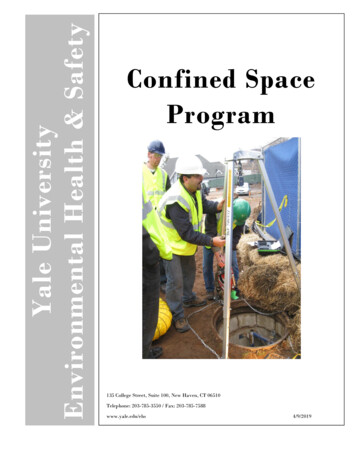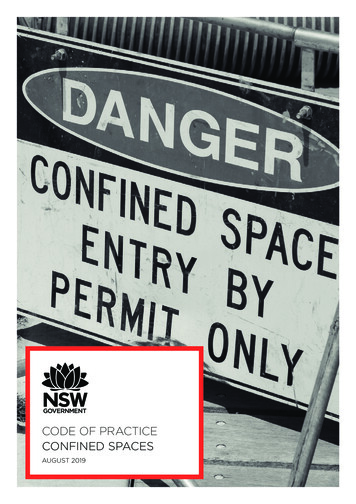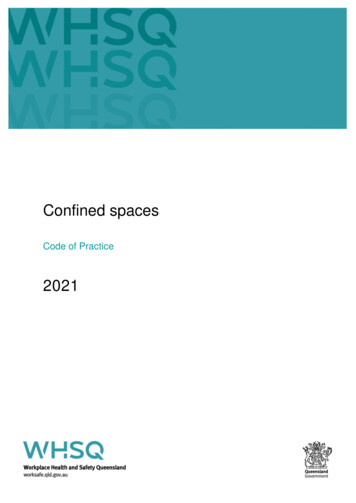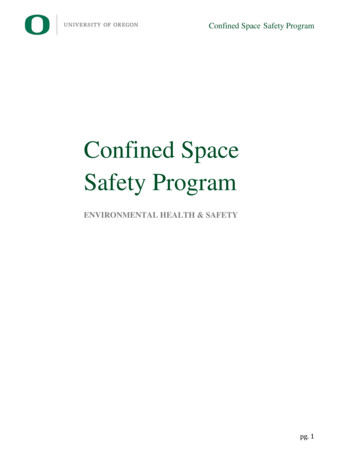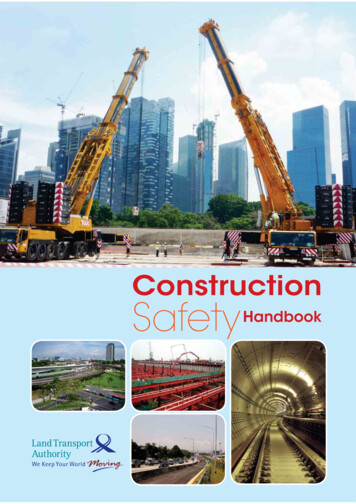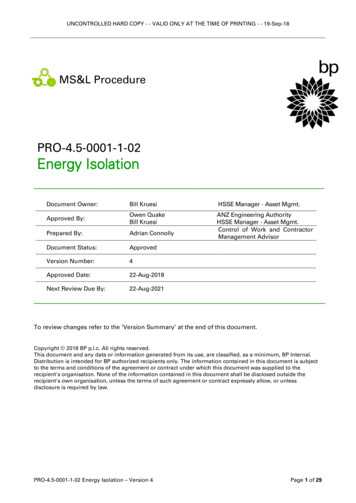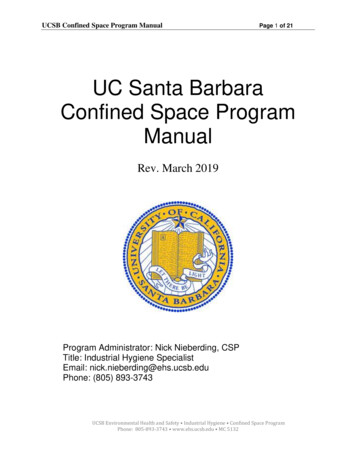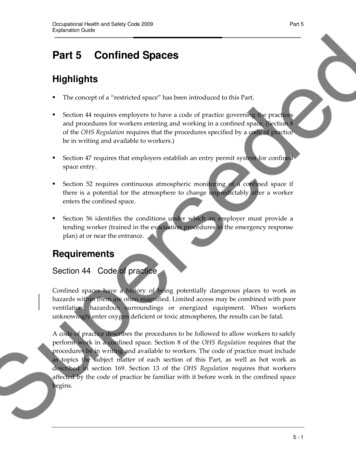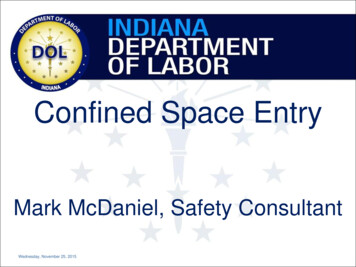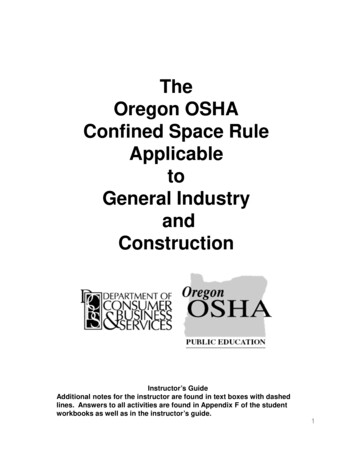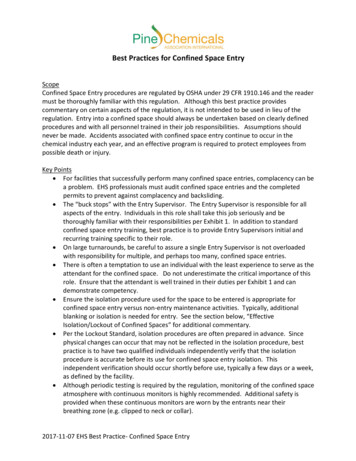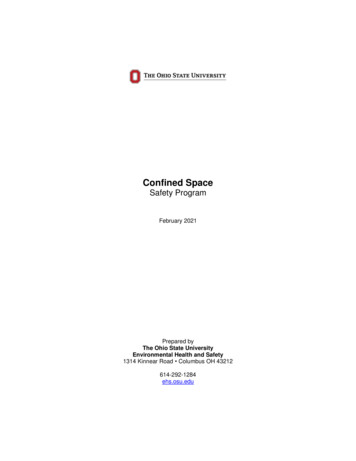
Transcription
Confined SpaceSafety ProgramFebruary 2021Prepared byThe Ohio State UniversityEnvironmental Health and Safety1314 Kinnear Road Columbus OH 43212614-292-1284ehs.osu.edu
Environmental Health and SafetyConfined SpaceSafety ProgramTable of Contents1. Introduction . 32. Responsibilities . 3Environmental Health and Safety . 3Authorized Entrants . 3Attendants . 3Supervisors . 4Departments. 4Contractors. 43. Definitions . 44. Identification of Confined Spaces. 55. Permit-Required Confined Space Entry Preparation . 5Training . 6Hazard Identification . 6Equipment . 6Pre-entry Atmospheric Testing . 7Isolation of Space . 76. Confined Space Entry Permit . 87. Confined Space Entry . 88. Rescue and Emergency Service . 99. Temporary Reclassification of Permit-Required Confined Space . 1010. Alternate Entry Procedures . 1011. Contractor Entry of Permit-Required Confined Space . 10Appendix A – Flowchart for Permit-Required Confined Space Entry . 11confined space program Feb 2021Page 2 of 11
Environmental Health and SafetyConfined SpaceSafety Program1.IntroductionConfined spaces are regulated under OSHA 29 CFR 1910.146 and OSHA 29 CFR 1926 Subpart AA. TheOhio State University workplace contains potentially hazardous enclosed spaces that may be classifiedas permit-required confined spaces or non-permit–required confined spaces. Examples of confinedspaces include manholes, vaults, tanks, tunnels, boilers, silos, bins, pits, crawl spaces, storm/sanitarydrains, and sumps. Employees may be required, as part of their job duties, to enter these spaces toperform inspection, repair, or maintenance activities. Spaces such as those mentioned above maycontain hazardous atmospheres, including chemical (toxic/flammable) vapors and/or oxygen deficiency.This program contains the procedures and practices for safe entry into locations at The Ohio StateUniversity (Ohio State) classified as permit-required and non-permit–required confined spaces. TheConfined Spaces Safety Program applies to all Ohio State employees whose job duties require them toenter or monitor confined spaces.2.ResponsibilitiesEnvironmental Health and SafetyEnvironmental Health and Safety (EHS) shall maintain, review, and update the Confined Space EntrySafety Program that includes the confined space location inventory, confined space entry standardoperation procedures (SOP), and confined space web-based training. Additionally, EHS can providemonitoring equipment for use during confined space entry.Authorized EntrantsAuthorized entrants are employees expected to enter a confined space. They are responsible forcomplying with the provisions outlined within this written program, including: Completion of confined space training.Knowledge of confined space locations and potential hazards.Understanding of what constitutes a hazardous condition or atmosphere in a confined space, howto identify when a hazardous condition is present, and emergency procedures.Properly completing and posting a confined space permit during entry into permit-requiredconfined spaces.Utilizing proper communication with the attendant to ensure information is accurately andfrequently provided.Donning the appropriate PPE before entry into a confined space and may include a full bodyharness for rescue operations, depending on the type of entry being performed.Being familiar with the rescue operations and plan before entry in the case of an emergency.AttendantsAttendants are employees stationed outside permit-required confined spaces who monitor the authorizedentrants. Attendants oversee the confined space entry without entry into the space. Attendants areresponsible for complying with the provisions outlined within this program, including: Completion of confined space training.Knowledge of confined space locations and potential hazards.confined space program Feb 2021Page 3 of 11
Environmental Health and SafetyConfined SpaceSafety Program Understanding what constitutes a hazardous condition or atmosphere in a confined space, how toidentify when a hazardous condition is present, and emergency procedures.Knowledge of the signs and symptoms of exposure to hazardous materials.Maintaining accurate count of authorized entrants.Communicating with authorized entrants to ensure safety and monitor status.Ensuring efficient exit from the confined space by all entrants in the event of an unsafe conditionor once work is complete.Ensuring prompt rescue of authorized entrant in the event of an emergency or unsafe conditionwhere the entrant is unable to perform self-rescue.Ensuring unauthorized personnel do not enter the confined space during work.SupervisorsSupervisors are responsible for ensuring employees are properly trained before entering a confinedspace. Additionally, supervisors shall: Ensure all confined spaces under their jurisdiction are properly identified by the appropriatesignage.Ensure rescue procedures are in place for each permit-required confined space entry.Determine if changes made to a non-permit–required confined space may present additionalhazards and be reclassified to a permit-required confined space.Provide training in a language and vocabulary that the worker understands.Document refresher training that is not conducted by EHS and retain records of that training.DepartmentsDepartments must notify EHS when changes are made to existing confined spaces or when new confinedspaces are identified.ContractorsContractors entering confined spaces must do so as outlined in this program and in accordance withapplicable OSHA regulations. Contractors must have a written confined space program that complies withthe regulations pertinent to the areas to be entered. Contractors also are responsible for supplying anyequipment necessary to perform safe entry into a confined space. When contractors enter a permitrequired confined space, they must have the permit posted during entry and may utilize the Ohio Stateform, if necessary.When there are multiple employers at the worksite, detailed provisions requiring the coordination ofactivities must be established. This will ensure hazards are not introduced into a confined space byworkers performing tasks outside the space. An example would be a generator running near the entranceof a confined space causing a buildup of carbon monoxide within the space.3.DefinitionsAuthorized entrant - Employee who has received the training and is authorized by supervisor to enter apermit-required confined space.Attendant - Individual stationed outside one or more permit spaces who monitors the authorized entrantsand who performs all attendant’s duties assigned in this program.confined space program Feb 2021Page 4 of 11
Environmental Health and SafetyConfined SpaceSafety ProgramEntry supervisor - Person responsible for determining if acceptable entry conditions are present at apermit space where entry is planned, for authorizing entry, overseeing entry operations, and terminatingentry as required by this section.Permit - Written procedure detailing the hazards within a permit-required confined space, methods toeliminate or control those hazards, equipment required, and authorization to enter the space.Rescue service - The personnel designated to rescue employees from confined spaces duringemergencies.Retrieval system - Equipment (including a retrieval line, chest or full-body harness, wristlets, ifappropriate, and a lifting device or anchor) used for non-entry rescue of people from permit spaces.4.Identification of Confined SpacesA confined space has all of these requirements:1. Is large enough and so configured that an employee can bodily enter and perform assigned work.2. Has limited or restricted means for entry or exit (for example, tanks, vessels, silos, storage bins,hoppers, vaults, and pits are spaces that may have limited means of entry.).3. Is not designed for continuous employee occupancy.Confined spaces are labeled with signage indicating “Danger Confined Space: Use Confined SpaceEntry Procedures” or similar wording.A permit-required confined is a confined space that has one or more of the following characteristics:1. Contains or has a potential to contain a hazardous atmosphere.2. Contains a material that has the potential for engulfing an entrant.3. Has an internal configuration such that an entrant could be trapped or asphyxiated by inwardlyconverging walls or by a floor that slopes downward and tapers to a smaller cross-section.4. Contains any other recognized serious safety or health hazard.Permit-required confined spaces are labeled with signage indicating “Danger-Permit Required ConfinedSpace: DO NOT ENTER” or similar wording.Departments responsible for confined spaces in their area should ensure the spaces are inspected on aregular basis to verify signage is present to prevent unauthorized access.Environmental Health and Safety is responsible for identification and the initial posting of signage for allOhio State Columbus campus confined spaces. If problems are discovered during an inspection,notification should be made to Environmental Health and Safety (614-292-1284) for resolution.5.Permit-Required Confined Space Entry PreparationEntry into a permit-required confined space occurs as soon as any part of the entrant's body breaks theplane of an opening into the space. Employees entering permit-required confined spaces must be trainedand knowledgeable of the hazards within the space and how to control or eliminate those hazards.confined space program Feb 2021Page 5 of 11
Environmental Health and SafetyConfined SpaceSafety ProgramA permit must be completed before entry into permit-required confined spaces where hazards cannot beeliminated or alternate entry procedures are not possible (Section 10. Alternate Entry Procedures).Proper equipment and rescue services must be available for permit-required entries.TrainingAll entrant supervisors, attendants, and authorized entrants shall be trained in areas relating to safeconfined space entry. Training shall be provided to employees before entry or attendance in/of a confinedspace and include all precautions to take when entering a confined space, including rescue operations.Retraining shall take place when: Changes arise in existing confined spaces requiring retraining.Newly established or identified confined spaces are introduced.An employee fails to follow procedures outlined in this program.There is an accident or injury resulting from confined space entry.Training must be documented to include the type of training, employee name, signature of trainer/trainee,and the date of training.Employees who work around confined spaces but do not enter permit-required confined spaces shouldtake the online EHS confined space training.Hazard IdentificationBefore entering a permit-required confined space, the entrants and attendants must understand thehazards that exist within the space. Hazards can include a dangerous atmosphere, such as low oxygen ortoxic gases or physical hazards such as moving parts or falls. Hazards also can be introduced into thespace as a result of the work being completed (e.g., hot work). Once hazards are identified, the propersteps must be taken to either eliminate or control those hazards before entry.The Confined Space Entry Permit includes a list of common hazards found within confined spaces.Employees can complete the hazard assessment portion of the permit to assist with their analysis of thespace.EquipmentEquipment must be provided and available for use during confined space entry depending on the hazardsand work associated with entry. Equipment may include: Air monitoring devices.Personal Protective Equipment (PPE), including full body harness, hard hat, hand/eye protection,and any other required.Rescue equipment.Communication devices.Ventilation devices.Lighting equipment.Barriers to prevent unauthorized access.Tools or equipment necessary to complete the required task.confined space program Feb 2021Page 6 of 11
Environmental Health and SafetyConfined SpaceSafety ProgramPre-entry Atmospheric TestingWhen actual or potential atmosphere hazards are identified, the atmosphere must be tested before entryand periodically throughout entry. A hazardous atmosphere is defined as one that may exposeemployees to the risk of death, incapacitation, and impairment of ability to self-rescue (that is, escapeunaided from a permit space), injury, or acute illness.Pre-entry air monitoring must be accomplished from outside the confined space. Use of extensionsand/or tubing should be utilized to capture air monitoring results from the breathing zone and variousdepths, if applicable, within the confined space.The following hazardous components of a confined space atmosphere must be tested and deemed safebefore entry: Oxygen – Oxygen levels must be between 19.5% - 23.5% to be declared safe for entry. Confinedspaces with oxygen levels outside this range may not be entered unless a Self-ContainedBreathing Apparatus (SCBA) is utilized by a fully trained authorized entrant. Atmospheres with oxygen levels less than 19.5% are considered oxygen deficient and lead toadverse health effects. Atmospheres with oxygen levels greater than 23.5% are considered oxygen enriched, whichposes a fire/explosion hazard. Oxygen levels may change during the course of work within a confined space throughdisplacement by other chemicals (nitrogen, carbon dioxide, welding/cutting/brazing off gases,etc.). Thus it is vital to continuously monitor the space during work.Combustible gases and vapors – Combustible gases and vapors are evaluated using a LowerExplosive Limit (LEL) detector. A volatile organic compound (VOC) detector also may be utilizedto detect the presence of chemicals, which may cause adverse effects. Before entry, the confined space must not contain elevated LEL or VOC levels to ensure thesafety of the workers performing the entry. LEL levels less than 10% may be deemed safe forentry. VOC levels, if detected, should be investigated to determine their source and attemptshould be made to clear the elevated levels before entry.Toxic gases and vapors – Toxic gases, specifically hydrogen sulfide and carbon monoxide, mustbe evaluated. Hydrogen sulfide is a common component of sewer gas and is a toxic material. The ceilingexposure limit is 20 parts per million (ppm) with a 10-minute peak of 50 ppm. Theimmediately dangerous to life and health (IDLH) is 100 ppm. Before entry, ensure no hydrogen sulfide gas is present within the confined space.Air monitoring data must be recorded on the Confined Space Permit.Isolation of SpaceIsolation is the process by which a confined space is removed from service and completely protectedagainst the release of energy and material into the space by such means as misaligning or removingsections of lines, pipes, or ducts; lockout or tagout of all sources of energy; or blocking or disconnectingall mechanical linkages. This will ensure the accidental release of energy or hazardous materials will notoccur while entrants are in the confined space.It may not be feasible to isolate a confined space (e.g., sewer system). In this situation, all air monitoring,PPE requirements, and other methods to control identified hazards must be followed.confined space program Feb 2021Page 7 of 11
Environmental Health and SafetyConfined SpaceSafety ProgramIsolation also involves ensuring pedestrian and vehicle access is blocked during all confined space entryactivities.6.Confined Space Entry PermitThe “permit” is the written authorization to be completed for each permit-required confined space entry.Information provided on the permit will identify key personnel involved in the entry, all monitoring data andother hazards, control measures, personal protective equipment, other applicable standards, andcommunication methods. The confined space entry permit is available online at the EHS website(https://ehs.osu.edu/resources?title confined space).The permit must be available for all authorized entrants for review and be posted outside the confinedspace during entry operations. The permit must be completed and signed before entry into the space.Additionally, the permit must be signed and dated at the termination of the permit.It is the responsibility of the entry supervisor to terminate the permit and remove personnel when entryoperations are complete or a hazard/condition arises making work unsafe.The following information must be documented on the permit: 7.Location and purpose of entry.Personnel involved in the entry, including entry supervisor, attendant(s), and authorizedentrant(s).Any additional permits or standards to be followed, including hot work, lockout/tagout/linebreaking or other. Follow all standard operating procedures and applicable standards andregulations if additional permitting is required.Adequate method of communication, such as portable radio use, hand signals, or unaided voice.Name and contact information for emergency services.Expected hazards within the space, including physical hazards (mechanical, electrical,engulfment, and/or entrapment), atmospheric hazards (oxygen deficiency, explosive, carbonmonoxide, and/or hydrogen sulfide), and other hazards (radiation, noise, heat, etc.).Control measures for identified hazards and known permits.Protective equipment, including both protection of the space from unauthorized entrance orintroduction of hazards to the confined space and personal protective equipment provided to theentrants.Initial and continuous results of the air monitoring within the confined space.Confined Space EntryOnce atmospheric testing has deemed the confined space safe for entry, other hazards have beenidentified and controlled, and the permit is complete and posted outside the confined space, theauthorized entrants are permitted to enter the confined space.During entry, each confined space must be assigned an attendant to remain outside the confined space,be in constant communication with the entrants, and be capable of summoning emergency rescuepersonnel in the event of an accident or hazardous exposure within the confined space.Attendants may be authorized to attend multiple confined spaces at one time, provided they canadequately respond to issues in any confined space without disrupting service to other spaces.confined space program Feb 2021Page 8 of 11
Environmental Health and SafetyConfined SpaceSafety ProgramAtmospheric hazards continuously must be monitored during entry and appropriate steps taken ifchanges take place resulting in unsafe breathing air or explosion/fire hazards.Once work is complete within the confined space, all authorized entrants must be removed safely fromthe space and the permit terminated and signed by the entry supervisor.8.Rescue and Emergency ServiceIt is the responsibility of the entrant supervisor to ensure rescue and emergency services are available toauthorized entrants of confined spaces in the event of an emergency requiring removal of personnel fromthe space. The supervisor must ensure there is a suitable rescue team to perform this function or thatauthorized entrants and attendants are properly trained to perform rescue and emergency services.Calling 9-1-1 may not be utilized as the primary rescue and emergency service resource but should becontacted in the event of an emergency or rescue to perform first aid or medical transport for injuredpersonnel.The rescue team or personnel identified to perform rescue operations must be trained adequately toperform the necessary tasks and equipped to do so. Additionally, the rescue personnel must meet thefollowing: Be provided with appropriate PPE to perform rescue operations.Be fully trained in rescue operations, including basic first aid and cardiopulmonary resuscitation(CPR).Complete and document annual rescue training operations consisting of review of rescue andemergency procedures and physical removal of dummy, manikin, or actual person from aconfined space or representative confined space.There are three types of rescue that may be employed in the confined space setting. These types arelisted below, in order of preference:1. Self-rescue – When an entrant can recognize a hazard and is able to exit from the space with noassistance.2. Non-entry rescue – When rescue is performed from outside the space.3. Entry rescue – When a rescuer must physically enter confined space.Regardless of the type of rescue, the use of retrieval systems, a full body harness with retrieval lineattached, must be utilized whenever a permit-required confined space is entered. The other end of theretrieval line must be attached to a mechanical device (hoist) or fixed point outside the confined space toensure prompt rescue can be performed if necessary. The only exceptions to this requirement are asfollows:1. A permit space with obstructions or turns that prevent pull on the retrieval line from beingtransmitted to the entrant.2. A permit space from which an employee being rescued with the system would be injured becauseof forceful contact with projections in the space.Self-rescue or non-entry rescue is preferred over entry rescue. Departments that are entering permitrequired confined spaces that could require an entry rescue should consult with EHS to ensure the safestpossible rescue plan is developed for the entry.confined space program Feb 2021Page 9 of 11
Environmental Health and SafetyConfined SpaceSafety Program9.Temporary Reclassification of Permit-Required Confined SpaceIn some circumstances, permit-required confined spaces can be reclassified temporarily as a non-permitspace if all of the following requirements are met: There is no actual or potential hazardous atmosphere in the space.Any hazards capable of causing death or serious injury have been eliminated before entry.The space can be reclassified as a non-permit space only for as long as the hazards remain eliminated. Ifsomeone must enter the space to remove the hazards, the space must be treated as a permit-requiredconfined space until the hazards have been eliminated.When temporarily reclassifying a permit-required confined space, the Temporary Reclassification ofPermit-Required Confined Space (https://ehs.osu.edu/resources?title confined space) form must becompleted and posted at the entrance of the confined space for the duration of entry. The flowchart inAppendix A can assist with determining which process should be followed when entering permit-requiredconfined spaces.10. Alternate Entry ProceduresWhen the only actual or potential hazard in a permit-required confined space is atmospheric, alternateentry procedures are allowable under the following conditions: You have eliminated all the physical hazards and continuous forced air ventilation controls theactual or potential hazardous atmosphere.Monitoring data demonstrates that continuous forced air ventilation will maintain the permitrequired confined space safe for entry.Follow the atmospheric testing guidance in Section 5 of this program. For alternate entry, only Part 3,Section A. of the Confined Space Entry Permit (ehs.osu.edu/resources) needs to be completed afterverifying the conditions above have been met. The flowchart in Appendix A can assist with determiningwhich process should be followed when entering permit-required confined spaces.11. Contractor Entry of Permit-Required Confined SpaceIf contractors are expected to enter Ohio State permit required confined spaces, the entrant supervisormust ensure that contractors: Are aware of the location and potential hazards of relevant confined spaces.Are informed of this program and specific procedures developed for the confined space.Have their own confined space entry program, including PPE, training, and rescue operations.confined space program Feb 2021Page 10 of 11
Environmental Health and SafetyConfined SpaceSafety ProgramAppendix A – Flowchart for Permit-Required Confined Space Entryconfined space program Feb 2021Page 11 of 11
The Ohio State University Environmental Health and Safety 1314 Kinnear Road Columbus OH 43212 614-292-1284 ehs.osu.edu . Environmental Health and Safety Confined Space . This program contains the procedures and practices for safe entry into locations at The Ohio State University (Ohio State) classified as permit-required and non-permit .
